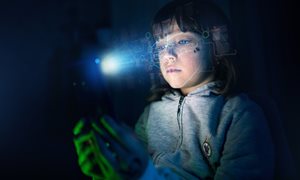
The hereditary cause of rare developmental disorders in children is often unknown. As a result, a diagnosis cannot be made. Researchers at Radboud university medical center have found a way to change that. They developed a computer model based on facial recognition. This allows doctors to make the correct diagnosis more often.
These days, geneticists are able to look at all 20,000 human genes using a single test. This often allows them to identify the hereditary cause of misunderstood developmental disorders in children. Examples of these are intellectual disability or autism spectrum disorders. About 1600 genes are currently known to be involved in these disorders, and this number increases every week. However, genes often contain many different defects. That is why it is not always clear whether or not they contribute to a developmental disorder. In these cases, a diagnosis cannot be made. Facial recognition can solve this problem, show researchers at Radboud university medical center.
Facial features
A developmental disorder is often accompanied by other physical features, including in the face. In these cases, it is called a syndrome. The researchers combined facial recognition with other data from the medical records of a group of children with forty different syndromes. They subsequently instructed a computer: recognize the syndromes based on this combination of data. This computer model was developed in collaboration with the research group of Marcel van Gerven, head of the department of Artificial Intelligence at Radboud University.
‘The computer model correctly recognized 37 syndromes’, says Lex Dingemans, researcher at the department of Human Genetics. ‘This allows the doctor to make the correct diagnosis more often in children with an abnormality in a certain gene. That is of great importance for very rare syndromes. For some of these syndromes, only a dozen individuals are known worldwide.’
The model can also identify relationships between abnormalities in the gene and the characteristics of the developmental disorder. ‘This offers opportunities for new treatments specifically aimed at these genetic abnormalities’, says Lisenka Vissers, one of the study leads. ‘We hope that we can offer these children personalized therapy in the future.’
Powerful tool
The model will not make a diagnosis by itself. ‘That responsibility always rests with the treating physician’, says clinical geneticist Bert de Vries, co-lead of the study. ‘Think of it as a very powerful tool. We are making this computer model freely available so that anyone can use it.’
De Vries indicates that the impact of making a diagnosis in these children should not be underestimated: ‘Family members often live in uncertainty for many years. For example, we recently diagnosed a syndrome in a child who we first examined fifteen years ago. Even after so many years, this provided clarity and a lot of peace for the parents and other family members.’
About the publication
This study was published in Nature Genetics: PhenoScore: AI-based phenomics to quantify rare disease and genetic variation. A.J.M. Dingemans, M. Hinne, K.M.G. Truijen, L. Goltstein, J. van Reeuwijk, N. de Leeuw, J. Schuurs-Hoeijmakers, R. Pfundt, I.J. Diets, J. den Hoed, E. de Boer, J. Coenen-van der Spek, S. Jansen, B.W. van Bon, N. Jonis, C.W. Ockeloen, A.T. Vulto-van Silfhout, T. Kleefstra, D.A. Koolen, P.M. Campeau, E.E. Palmer, H. van Esch, G.J. Lyon, F.S. Alkuraya, A. Rauch, R. Marom, D. Baralle, P.J. van der Sluijs, G.W.E. Santen, R.F. Kooy, M.A.J. van Gerven, L.E.L.M. Vissers, B.B.A. de Vries. DOI: 10.1038/s41588-023-01469-w.
-
Want to know more about these subjects? Click on the buttons below for more news.
News homepage news & mediaArtificial intelligenceZeldzame aandoeningen







